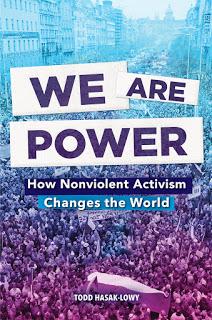Welcome to the We Are Power Blog Tour!
To celebrate the release of We Are Power by Todd Hasak-Lowy, blogs across the web are featuring original content from Todd and profiles of key figures in social activism history from We Are Power, as well as 5 chances to win a finished copy!
The Silent Sentinels
by Todd Hasak-Lowy
Because America’s suffragists won the right to vote a couple of decades before Gandhi’s methods were adopted in the U.S., these incredible women are rarely mentioned in histories of nonviolence. But, in fact, they and their leader, Alice Paul, used escalating, confrontational protest to force President Woodrow Wilson to back their call for a constitutional amendment. This short snippet from my book narrates the birth of the Silent Sentinels, whose banners spoke volumes.
They took their positions and raised their banners high. The messages read:
MR . PRESIDENT WHAT WILL YOU DO FOR WOMAN SUFFRAGE
MR . PRESIDENT HOW LONG MUST WOMEN WAIT FOR LIBERTY
The Silent Sentinels, as these and similar protesters came to be known, were the first Americans ever to picket the White House. They would stand before the president’s home seven hours a day, six days a week, no matter the weather, for most of 1917 and into 1918.
Alice Paul, the leader of the Sentinels, organized the pickets using military language, because this peaceful act was designed to create conflict. She gave out “General Orders,” and referred to herself as “Commandant,” while various suffragists would act as “Officer of the Day.” “Privates” had “Morning Detail,” when only the “Sergeant of the Guard” was allowed to communicate with the press.
The Sentinels received elaborate instructions on how to respond to police interference. They were given a detailed list of alternate locations to occupy near the gates if forced to move. A last resort would be to march from gate to gate, but under no circumstances were they to fight back.
Over the course of a year, some two thousand women would take turns holding banners, whose messages changed constantly. These women hailed from virtually every state in the nation, though most lived along the East Coast. They tended to be educated and come from wealthy families, but there were working- class women and immigrants among them as well. Most were in their twenties or thirties, yet some were much, much older.
What they all had in common was not only the belief that President Wilson needed to be confronted, but also the willingness to challenge him publicly day in and day out, for long hours, whatever the weather. Their intense commitment to the cause of women’s suffrage took them away from their homes, their families, and their careers. Challenging the president publicly opened them to ridicule and, in time, much worse.
The banner was the suffragists’ answer to their apparent powerlessness. These women couldn’t simply force those in power to give them what they wanted, at least not violently. In 1919, Doris Stevens, a leading suffragist of the time, listed “every known scientific device” used “to annihilate the enemy.” She mentioned bayonets, poison gas, tanks, and much more.
“We could not and would not fight with such weapons,” Stevens wrote. “How could we, with reasonable speed, rout the enemy without weapons, and we a class without power and recognition? Our simple, peaceful, almost quaint device was a BANNER!”
As these first Sentinels took their positions by White House gates, a new chapter in the fight for women’s suffrage began. Over the next few years their banners took these and many other brave women from those gates to police stations, courtrooms, jails, and, finally, the voting booth.
*****
Blog Tour Schedule:
May 4th – The Fandom
May 5th – Big Shiny Robot
May 6th – BookHoundsYA
May 7th – Mundie Moms
May 8th – A Dream Within a Dream
★ “Hasak-Lowy’s writing gives life to both the people and issues involved, taking time to explain historical backgrounds and the ways the lessons from one movement affected future ones.”
— Booklist, STARRED REVIEW
★ “Highly recommended for its outstanding treatment of the history of social justice. A good resource for student activists.”
— School Library Journal, STARRED REVIEW
★ “There has never been a time when a book is more relevant than this one.”
— School Library Connection, STARRED REVIEW

Buy: Amazon | Abrams | Bookshop | IndieBound
Follow Todd: Website | Twitter | Instagram | Facebook
A stirring look at nonviolent activism, from American suffragists to Civil Rights to the Climate Change Movement
We Are Power brings to light the incredible individuals who have used nonviolent activism to change the world. The book explores questions such as what is nonviolent resistance and how does it work? In an age when armies are stronger than ever before, when guns seem to be everywhere, how can people confront their adversaries without resorting to violence themselves? Through key international movements as well as people such as Gandhi, Alice Paul, Martin Luther King, Cesar Chavez, and Václav Havel, this book discusses the components of nonviolent resistance. It answers the question “Why nonviolence?” by showing how nonviolent movements have succeeded again and again in a variety of ways, in all sorts of places, and always in the face of overwhelming odds. The book includes endnotes, a bibliography, and an index.

About the Author
Todd Hasak-Lowy is the author of several books for young readers. He is a professor of creative writing and literature at the School of the Art Institute of Chicago. Hasak-Lowy lives in Evanston, Illinois, with his wife and two daughters. Visit toddhasaklowy.com.
GIVEAWAY

- 1 winner will receive a finished copy of We Are Power. Check out the other tour stops for more chances to win.
- US/Canada only
- Ends 11:59pm ET on 5/16